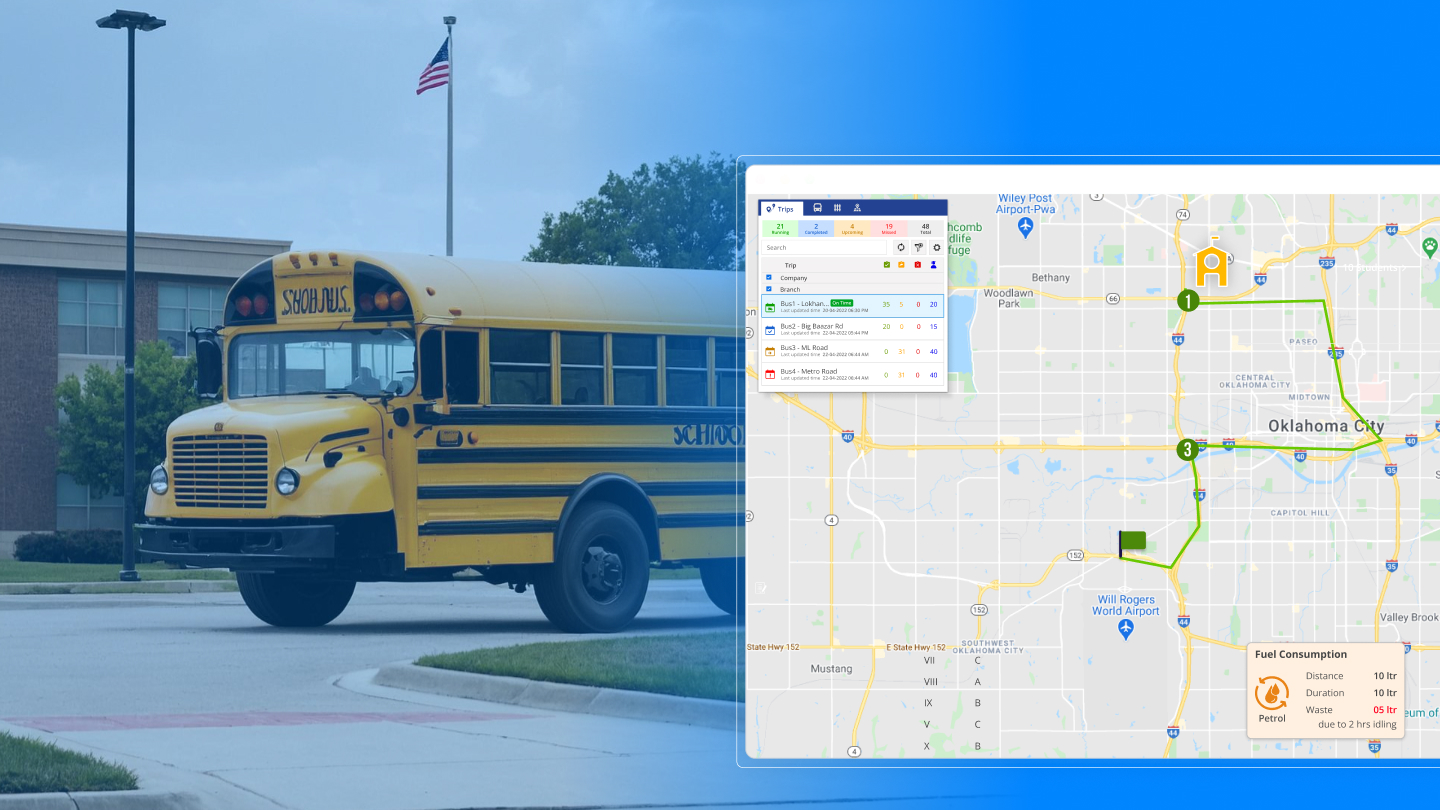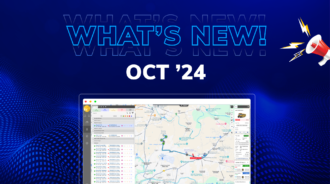Smart Route Optimization for School Bus Efficiency

On the other hand, urban areas struggle with irregular delays and traffic jams. The complexity of city traffic patterns makes it difficult to maintain a consistent schedule, leading to frequent delays and frustration for students and parents alike. An organized, dependable system is required in both urban and rural environments.
Traditional route planning methods are often inadequate in addressing these challenges. Manual planning struggles to adapt to real-time variables such as traffic changes, road construction, and weather conditions. This lack of adaptability leads to inefficiencies, increased fuel consumption, and higher operational costs. School districts require a solution that ensures students arrive safely and on time, reduces operational costs, and eases the burden on drivers.
Smart Route Optimization—a technology-driven solution designed to revolutionize school bus commutes. This system utilizes advanced algorithms and real-time data to create efficient, safe, and cost-effective bus routes. The transformation from inefficiency to streamlined operation begins here.
The Need for a Modern Solution
Modern problems require modern solutions. The need for a smarter, more efficient system is clear. Schools and transportation departments must embrace technology to address these challenges. Smart Route Optimization emerges as the solution.
Real-time data and advanced algorithms are used in smart route optimization. It creates the most effective routes by taking into account every relevant factor. This technology-driven approach promises to transform school bus commutes.
The goal is simple: to create a system that works for everyone. Students should have shorter, safer commutes. Parents should feel reassured about their child’s journey. Drivers should navigate clear, efficient routes. Schools should save on costs and improve overall efficiency.
Implementing Smart Route Optimization
One school district decided to implement this system. They faced numerous challenges with their current bus routes. There were both rural and urban areas in the district. Traffic jams were a daily issue. The long routes tired students and stressed parents.
The school district partnered with a company specializing in Smart Route Optimization. They started by gathering data. They collected information on student addresses, traffic patterns, and bus capacities. The company then used this data to design optimized routes.
The implementation phase involved training the drivers. They learned to use the new system. The district also informed parents about the changes. Communication was key to the success of the project. The district ensured everyone was on board.
Initially, there were opposing views. Some parents and drivers were concerned. They were concerned that their routines might be affected by the changes. The district addressed these undertakings through clear communication and support. They held meetings to explain the benefits of the new system.
The Impact of Smart Route Optimization
The results were impressive. The new routes reduced travel time by 25%. Students arrived at school on time, feeling more refreshed. Parents noticed the difference and appreciated the improved safety. Drivers found their job less stressful. They no longer had to navigate through confusing and congested routes.
Fuel consumption dropped significantly. The district saved money, which they redirected to other educational needs. The environmental impact was positive too. Fewer emissions meant a cleaner environment.
Teachers noticed a difference in students’ performance. They were more attentive and participated actively in class. The overall environment in the school improved.
Students benefited immensely from the reduced commute times. They arrived at school more alert and ready to learn. The stress of long bus rides was gone. This change is reflected in their academic performance and social interactions.
Parents appreciated the transparency the system provided. They could track the bus in real-time using a mobile app. This feature gave them peace of mind. They knew exactly when their child would arrive at school or home. The reliability of the bus schedule helped them plan their day better.
Drivers reported a significant reduction in their stress levels. The optimized routes meant less time stuck in traffic. Clear instructions from the system helped them navigate efficiently. They could focus more on driving safely rather than worrying about the route.
Overcoming Challenges
Implementing a new system is never without challenges. The school district faced initial resistance from some parents and drivers. They feared the change would disrupt their routines. The district addressed these concerns through clear communication and support.
Technical problems were another issue. The tech company provided prompt support to resolve these problems. Continuous training for drivers ensured they were comfortable with the new system. The district also set up a helpdesk to assist parents and drivers with any issues.
One of the significant challenges was data collection. Accurate and comprehensive data was crucial for the system to work effectively. The district had to ensure they had the latest information on student addresses, traffic patterns, and bus capacities. This data collection process required time and effort.
Training drivers was another critical aspect. The new system meant a change in how they operated. The district organized several training sessions. They provided hands-on experience with the new technology. This training helped drivers become comfortable and confident with the system.
Communication with parents was equally important. The district used various channels to reach out to parents. They sent emails, held meetings, and provided detailed brochures. This comprehensive communication strategy helped address any concerns and built trust.
Community Support and Involvement
Community involvement is vital for the success of such initiatives. The school district engaged with the community from the start. They held meetings to explain the new system. Parents and community members could ask questions and express concerns. This transparency built trust and support.
The district also involved local authorities. They worked with traffic management teams to ensure smooth implementation. This cooperation ensured that the optimized routes aligned with broader city traffic plans. Local authorities appreciated the proactive approach to reducing jams and improving road safety.
Comprehensive Communication Strategy
Effective communication played an essential role in the success of the Smart Route Optimization project. The school district implemented a comprehensive communication strategy to keep all stakeholders informed and engaged.
Regular Updates
The district provided regular updates to parents, students, and staff. They used newsletters, emails, and social media to share progress and address concerns. This transparency helped build trust and confidence in the new system.
Interactive Sessions
The district organized interactive sessions with parents and community members. These sessions allowed people to ask questions and provide feedback. The district addressed concerns promptly, which helped diminish any fears about the new system.
Training Workshops
Training workshops were essential for drivers and staff. The district conducted hands-on workshops to familiarize them with the new technology. These sessions ensured that everyone was comfortable using the system and understood its benefits.
Feedback Mechanism
The district established a strong feedback mechanism. They encouraged parents, students, and drivers to share their experiences. This feedback was crucial for identifying areas of improvement and ensuring that the system is constantly improved.
Real-Time Monitoring and Safety
One of the standout features of Smart Route Optimization is real-time monitoring. GPS tracking allows parents and the school to monitor the buses in real-time. This feature provides several safety benefits.
Enhanced Security
Parents can track the exact location of the bus through a mobile app. This feature reassures them about their child’s safety. They can see when the bus arrives at the stop and when it reaches the school.
Emergency Response
In case of emergencies, real-time monitoring allows for quick response. If a bus encounters a problem, the system can alert the authorities and provide the exact location. This feature ensures that help reaches the bus promptly.
Dynamic Route Adjustments
Traffic conditions can change rapidly. The real-time monitoring system adjusts the routes dynamically. If there is an accident or heavy traffic, the system finds the best alternative route. This flexibility ensures that buses avoid delays and students reach school on time.
Improved Attendance
With shorter, more predictable commutes, students arrived at school on time more consistently. This improvement in attendance positively affected their academic performance. They didn’t miss important lessons or activities, which contributed to better overall grades.
Driver Satisfaction and Efficiency
The new system also had a significant impact on the drivers. Their job became easier and more efficient.
Drivers received clear, optimized routes. They didn’t have to worry about navigating through confusing or congested areas. The system provided real-time updates, ensuring they always had the best possible route.
Professional Development
The training provided to drivers enhanced their skills. They felt more competent and confident using modern technology. This professional development was a valuable addition to their career, improving their prospects and job satisfaction.
Community and Stakeholder Engagement
The success of the Smart Route Optimization project was a result of strong community and stakeholder engagement.
Building Trust
The district’s transparent communication strategy built trust within the community. Regular updates, interactive sessions, and a positive feedback mechanism ensured that everyone felt involved and informed. This trust was crucial for the smooth implementation of the new system.
Collaborative Approach
The district adopted a collaborative approach. They involved parents, drivers, teachers, and local businesses in the process. This inclusive strategy ensured that everyone had a stake in the success of the project.
Positive Publicity
The successful implementation of Smart Route Optimization brought positive publicity to the district. Media coverage highlighted the benefits of the system. This positive exposure enhanced the district’s reputation as a forward-thinking, innovative, and community-focused institution.
Continuous Improvement
The district committed to continuous improvement. They asked for input and routinely examined the system’s performance. This proactive approach ensured that the system remained effective and met the evolving needs of the community.
Future Prospects
The success of Smart Route Optimization in this school district sets an example. Other districts can learn from this experience. Technology continues to evolve. Future advancements promise even more efficiency and safety.
Integration with Other Technologies
Schools can integrate other technologies with Smart Route Optimization. For example, smart traffic lights can further reduce delays. These lights can prioritize school buses, ensuring they have a smooth passage through busy intersections.
Advanced Analytics
The future of Smart Route Optimization lies in advanced analytics. More sophisticated algorithms can analyze larger datasets. These algorithms can provide deeper insights and more accurate predictions. This advancement will further enhance route efficiency and safety.
Personalized Routes
Personalized routes could be the next big step. The system can tailor routes based on individual student needs. For example, it can consider specific pick-up and drop-off preferences. This customization ensures that the system meets the unique needs of every student.
Smart Route Optimization transforms school bus commutes. It addresses common challenges and offers noticeable benefits. The success story of this school district highlights the potential of the technology. By focusing on efficiency, safety, and community involvement, schools can create a better commuting experience for everyone.




